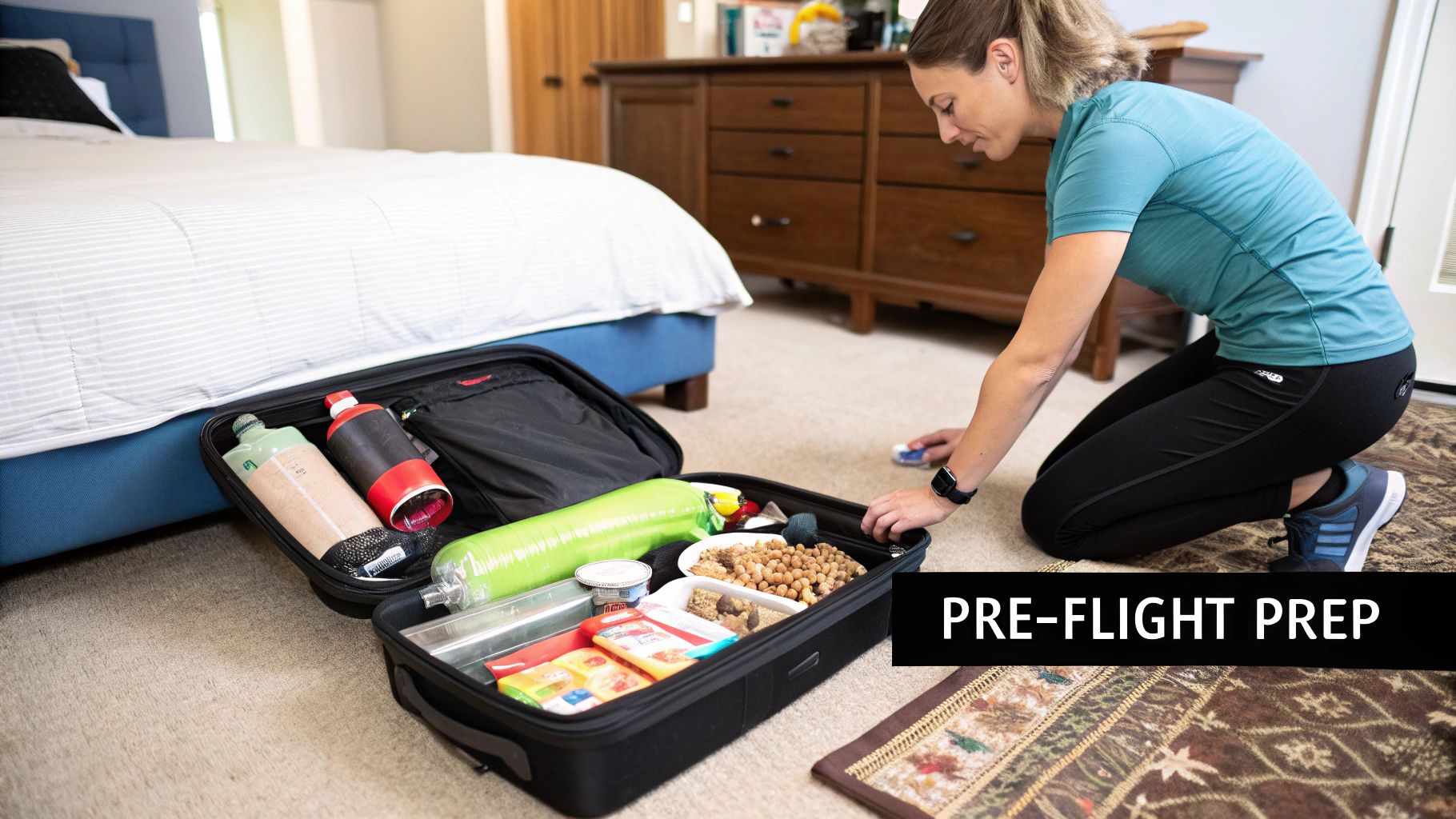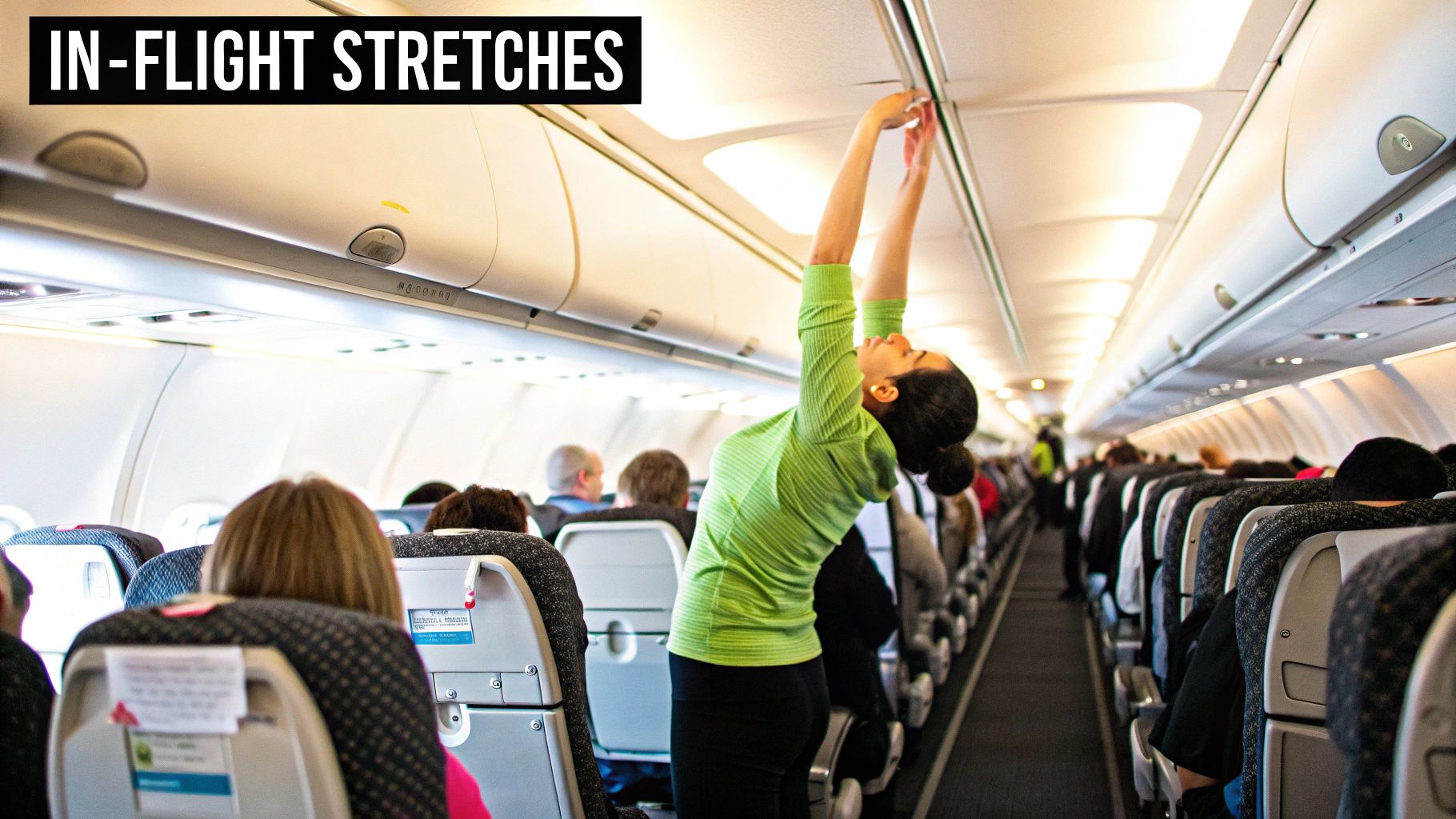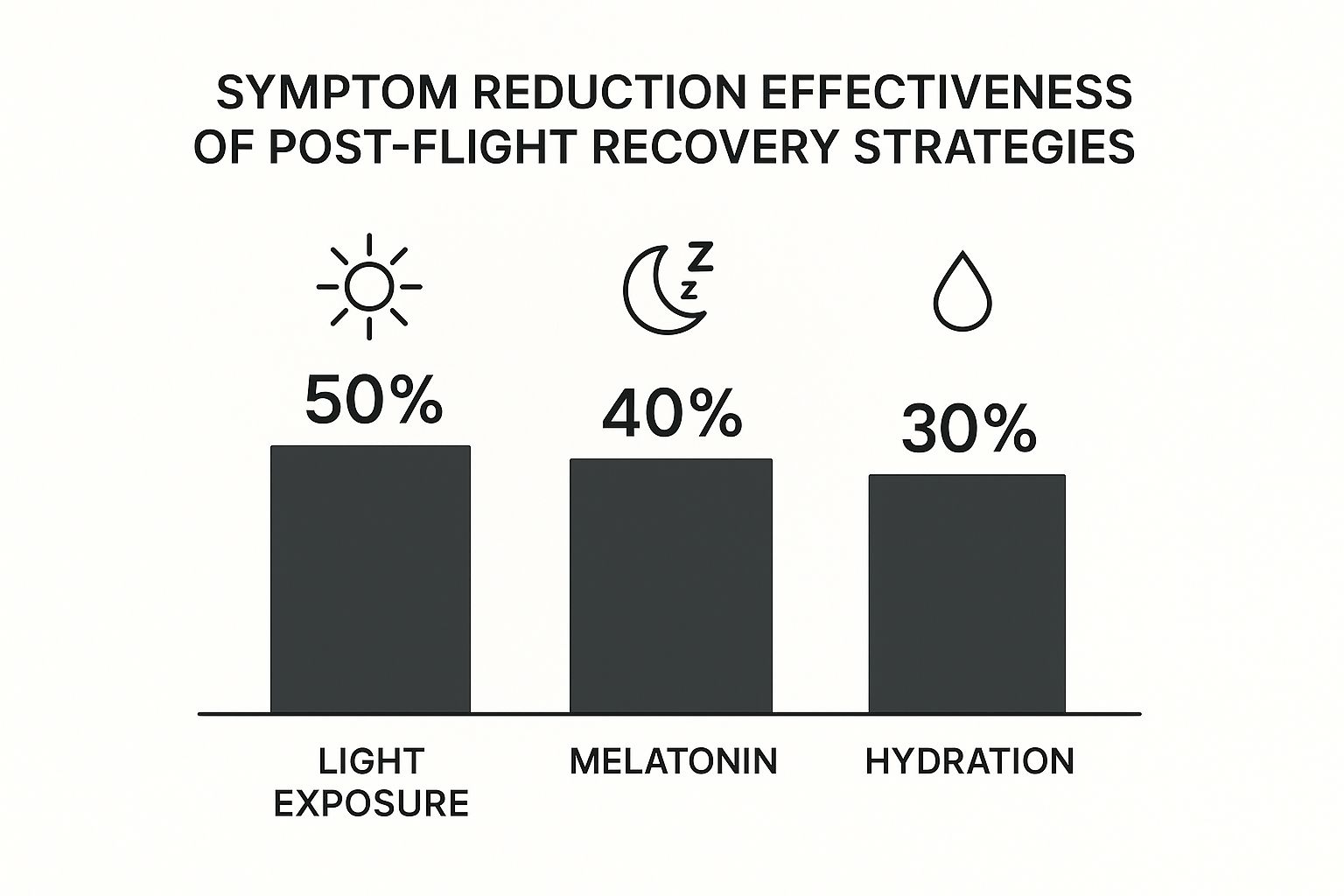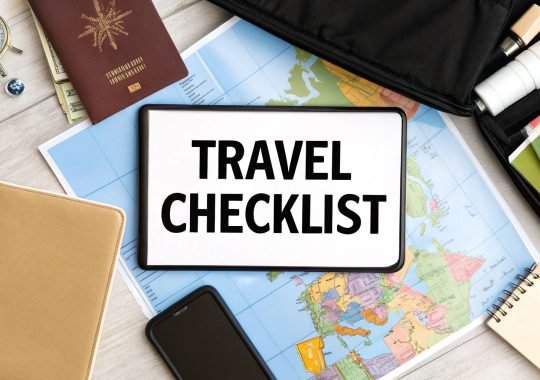If you ask any seasoned traveler their secret to beating jet lag, they’ll tell you the same thing: the battle is won before you even leave for the airport. Your game plan needs to kick in days before your flight. It’s all about a little proactive effort—gently adjusting your sleep, staying on top of hydration, and packing a carry-on that sets you up for in-flight success.
Your Pre-Flight Plan to Conquer Jet Lag
Landing in a new time zone feeling refreshed isn’t about luck; it’s about preparation. The steps you take in the 48-72 hours before you take off make all the difference in how your body handles the shock. I like to think of it like training for a marathon. You wouldn’t just show up on race day without any training, and the same mindset applies to surviving a long-haul flight.
The whole goal here is to start nudging your internal clock—your circadian rhythm—in the right direction. A gentle push now is far better than a hard shove later.
Start Shifting Your Sleep Schedule
This is a simple trick, but it’s incredibly effective. A few days before you fly, start tweaking your bedtime to get closer to your destination’s schedule.
- Flying East? (e.g., New York to Paris): Start going to bed and waking up an hour earlier each night. This essentially “shortens” your day and gives your body a head start on adjusting to the time jump ahead.
- Flying West? (e.g., Los Angeles to Tokyo): Do the opposite. Go to bed and wake up an hour later each night. You’re basically practicing for the later nights you’ll need to pull at your destination.
This gradual approach makes the final time zone switch feel much less jarring. It’s a small amount of effort that pays off big time by cutting down on that dreaded first-day grogginess.
Optimize Your Pre-Flight Diet and Hydration
What you eat and drink in the days leading up to your flight matters more than you might think. Steer clear of heavy, greasy, or rich foods that can mess with your sleep and digestion. Instead, I stick to lighter meals and make hydration my top priority. Dehydration is a huge part of why you feel so terrible after a long flight, so start chugging extra water well before you leave home.
My Personal Rule: No alcohol and minimal caffeine for at least 24 hours before a long-haul flight. Both are diuretics that dehydrate you and can seriously interfere with getting good, quality rest before you travel.
This strategy is especially crucial for people who travel for work. It’s no surprise that business travelers make up a huge chunk of the jet lag therapy market—around 42.87%, in fact. For them, arriving tired isn’t just an inconvenience; it can impact their performance. While many rely on pharmacological aids (which account for over half the market), making these simple behavioral changes is a powerful, drug-free way to stay sharp. If you’re curious about these trends, Data Bridge Market Research has some fascinating insights.
Pre-Flight Jet Lag Prevention Checklist
To make it easy, here’s a quick-glance table of the key actions to take in the days leading up to your trip. Think of this as your pre-boarding ritual for arriving refreshed.
| Action Item | Timing | Primary Benefit |
|---|---|---|
| Gradually Adjust Bedtime | 2-3 days before flight | Gently shifts your circadian rhythm closer to the destination’s time. |
| Increase Water Intake | 48 hours before flight | Combats in-flight dehydration, a major cause of fatigue and headaches. |
| Eat Light, Healthy Meals | 24-48 hours before flight | Prevents digestive discomfort and promotes better pre-flight sleep. |
| Avoid Alcohol & Caffeine | 24 hours before flight | Improves hydration and allows for higher quality, restorative rest. |
| Pack a “Sleep Kit” | The day before you fly | Ensures you have everything needed to create a restful environment on the plane. |
Following these steps sets the stage for a much smoother transition once you’re in the air and after you land.
Pack Your Carry-On for Success
Your carry-on isn’t just for your laptop and a change of clothes; it’s your personal jet lag survival kit. Packing it strategically means you can create a comfortable little cocoon, even if you’re stuck in the middle seat in economy.
Here’s what’s always in my bag:
- A high-quality, contoured eye mask that completely blocks out light.
- Noise-canceling earbuds or headphones are a non-negotiable for me.
- A travel pillow that actually supports your neck (not one of those flimsy ones).
- An empty reusable water bottle I can fill up after I get through security.
Knowing how to pack efficiently is a travel skill that pays dividends, ensuring you have your essentials without lugging around a heavy, overstuffed bag. A little planning here gives you the best shot at stepping off the plane feeling human and ready to explore.
Mastering Your In-Flight Jet Lag Routine

Once those cabin doors close, your fight against jet lag enters its most critical phase. The best way to think about the airplane cabin is as your personal time machine. Every choice you make inside it will dictate whether you step off feeling groggy and out of sync or surprisingly refreshed and ready to go.
This isn’t dead time; it’s an active part of your adjustment.
Your very first move—before the plane even leaves the gate—should be to set your watch and phone to your destination’s time. It sounds almost too simple, but this is a powerful psychological trick. It immediately starts reframing your mindset, helping you align everything you do next—eating, sleeping, working—with the local schedule you’re flying toward, not the one you left behind.
Prioritize Smart Hydration
The air inside an airplane cabin is notoriously dry and recycled. That intense dehydration is a major culprit behind the classic post-flight headache and fatigue that so many travelers know well. Your best friend at 35,000 feet is, without a doubt, water. Drink it constantly, even if you don’t feel thirsty.
It’s just as important to know what not to drink. That complimentary glass of wine might seem tempting, but alcohol is a massive dehydrator and wrecks the quality of any sleep you might get. The same goes for caffeine. A coffee might feel like the right call to stay awake, but it can backfire by messing with your ability to rest when you actually need to, scrambling your body clock even more. Stick with water.
Master Light and Darkness
Light is the single most powerful signal for resetting your body’s internal clock. You can use this to your advantage by strategically managing your exposure to it right from your seat.
- When it’s daytime at your destination: Keep that window shade open. Let the natural light pour in. This sends a clear message to your brain that it’s time to be awake and alert.
- When it’s nighttime at your destination: This is your cue to create a personal night. A high-quality eye mask is essential here to block out all the cabin lights and screen glare. This signals to your brain that it’s time to produce melatonin and prepare for sleep.
Your goal is to live on destination time, even while you are in the air. If it’s 2 AM in London (your destination), you should be doing everything possible to encourage sleep, regardless of what time your body thinks it is.
Keep Your Body Moving
Being stuck in a seat for hours on end is just plain tough on the body, leading to stiffness, poor circulation, and general discomfort. You don’t need to do a full workout in the aisle, but simple, in-seat movements can make a world of difference in how you feel when you land.
Try doing some ankle circles, gentle neck rolls, and shoulder shrugs every so often. These small movements boost blood flow and keep you from feeling so stiff and achy. For even more great ideas, check out these excellent tips for surviving long-distance flights.
And don’t be shy about getting up. Taking a short walk up and down the aisle every hour or two is a fantastic way to stretch your legs and fight off that sluggish feeling. These little actions are a key part of your in-flight strategy to beat jet lag and arrive feeling much more human.
Your First 48 Hours: A Post-Flight Survival Guide

You’ve landed, but the real battle has just begun. The choices you make in these first 48 hours at your destination will either make or break your trip, determining how fast you kick jet lag to the curb. This isn’t the time to listen to what your exhausted body thinks it wants; it’s time to take control and immediately sync up with your new environment.
The number one rule is non-negotiable: live on local time from the second you step off the plane. If you land at 9 AM and your internal clock is screaming that it’s 2 AM, your first move is to find breakfast, not a bed. Eating your meals on the local schedule is a powerful signal that helps reset your body’s internal clock, which is heavily influenced by your gut.
Harness the Power of Natural Light
Light is hands-down the most powerful tool you have for resetting your circadian rhythm. Think of sunlight as the master switch for your body clock. How you use it in the first two days depends entirely on which direction you’ve flown.
- After Flying East (e.g., USA to Europe): Your main goal is to advance your clock. You need to get bright, natural sunlight as early as you can in the morning. Ditch the sunglasses and take a brisk walk to a local cafe. This exposure tells your brain to slam the brakes on melatonin production and wake up.
- After Flying West (e.g., Europe to the USA): Here, you want to delay your clock. Try to avoid bright morning light if you can, but make it a point to get outside for some sun in the late afternoon and early evening. This helps push your bedtime later, making it much easier to adjust.
This strategic light exposure is a game-changer. It’s a fundamental step that will dramatically speed up your adaptation and minimize those dreaded jet lag symptoms.
Resisting that overwhelming urge for a mid-afternoon nap is one of the toughest parts of beating jet lag. If you absolutely must give in, keep it to a strict 20-minute power nap before 3 PM local time. Any longer or later, and you’ll sabotage your chances of sleeping through the night.
Stay Active and Just Say No to the Nap
Movement is your best friend when fighting post-flight fatigue. You don’t need a grueling workout, but some light physical activity can do wonders for boosting alertness and shaking off the grogginess. A simple walk around your new neighborhood not only helps you stay awake but also gets you that crucial natural light and helps you get your bearings.
The mission is to push through until a reasonable local bedtime—think 9 or 10 PM. This single act of endurance on day one will massively accelerate your recovery.
Sometimes, understanding the science behind the struggle helps. For example, a massive study analyzing 1.5 million nights of travelers’ sleep found something fascinating. While the total amount of sleep might bounce back quickly, the quality and timing of that sleep—including the critical REM and deep sleep stages—can take over a week to fully realign. This just underscores why being so disciplined in your first 48 hours is critical for a full recovery.
To get a leg up on post-flight fatigue and reset your clock, establishing solid sleep patterns is everything. Discovering effective strategies for better sleep is essential for making these first two days count.
Using Technology and Supplements Wisely
In the fight against jet lag, modern tools and supplements can be your secret weapon—but only if you know how to use them. It’s all about being strategic and learning to separate the scientifically-backed aids from the marketing fluff. A smart, informed approach here can make a huge difference in how quickly you bounce back.
One of the best things I’ve started doing is using a jet lag app for my long-haul trips. These apps take your specific flight path, travel direction, and even your usual sleep schedule to build a custom plan. They tell you exactly when to get some sun, when to stay in the dark, and even when to time your coffee. It completely takes the guesswork out of adjusting.
Understanding Melatonin
Melatonin is easily the most famous supplement for sleep, but it’s also one of the most misunderstood when it comes to jet lag. So many travelers just pop a high-dose pill, thinking it will knock them out on the plane. But melatonin isn’t a sleeping pill; it’s a hormone that tells your body it’s nighttime.
The real magic is in the timing and dosage, not brute force.
- Less Is More: Your body naturally produces melatonin in very small amounts. A massive dose just overwhelms your system. I always recommend starting low, around 0.5mg to 1mg, taken about 30 minutes before you want to go to sleep in your new time zone.
- Timing Is Everything: Taking melatonin at the wrong time can actually push your body clock in the wrong direction. The whole point is to take it to help you fall asleep at a normal local bedtime, not to force sleep mid-flight when it might be bright and sunny at your destination.
Think of melatonin as a gentle nudge for your internal clock, not a sledgehammer. Using it strategically helps your body sync up with the new time zone much more smoothly.
This is a great visual for understanding just how powerful different strategies are for getting your body clock back on track.

As you can see, while a supplement like melatonin is a big help, nothing beats managing your light exposure. It’s the single most effective tool you have.
The direction you’re flying makes a huge difference in how you should use light and melatonin to your advantage. It’s not a one-size-fits-all approach.
Jet Lag Aid Comparison Westbound vs Eastbound Travel
| Travel Direction | Morning Strategy | Evening Strategy |
|---|---|---|
| Westbound (e.g., USA to Asia) | Get bright morning light upon arrival. This helps delay your internal clock, making it easier to stay awake later. Avoid sunglasses in the morning. | Avoid bright light in the late evening. Take a low-dose melatonin (0.5mg) in the late evening, a few hours before your target bedtime, to help you feel sleepy earlier. |
| Eastbound (e.g., USA to Europe) | Avoid bright morning light for the first few days. Wear sunglasses if you have to be outside. This prevents your clock from being pushed even earlier. | Get as much afternoon and early evening light as possible. This helps advance your clock. Take melatonin (0.5mg to 1mg) 30 minutes before your new, earlier bedtime. |
Ultimately, a little planning based on your flight path can make these tools incredibly effective.
Other Helpful Supplements
While melatonin gets all the glory, a few other supplements are great to have in your travel kit. Flying is stressful on the body, and keeping your immune system happy is always a good idea.
I usually pack these for any long trip:
- Vitamin D: If you’re flying to a place with less sun than you’re used to (hello, London in winter), a vitamin D supplement can give your immune function a nice boost.
- Zinc: You’re stuck in a metal tube with recycled air and a lot of new germs. A little zinc can help keep your defenses up.
- Electrolytes: That dry cabin air is incredibly dehydrating. I always add an electrolyte powder to my water bottle; it replenishes essential minerals and fights off dehydration much better than plain water.
By pairing smart tech with a careful and informed supplement strategy, you’re giving your body the best shot at a quick and painless recovery.
Jet Lag Strategies for Frequent Flyers

If you practically live out of a suitcase, you know that managing jet lag is about much more than just feeling a little tired. It’s about protecting your long-term health and staying on top of your game, trip after trip. When you’re constantly hopping across time zones, the basic advice just doesn’t cut it. Your mission isn’t just to get through one trip—it’s to build a rock-solid, sustainable routine that keeps burnout at bay.
The pressure on frequent travelers is no joke, and it reflects a massive global trend. Just look at the numbers in North America. U.S. airlines recently carried around 83.3 million passengers in a single month. Up north, Canadian business travel spending has rocketed to $25.9 billion, growing at a staggering 13.5% each year. This non-stop movement fuels a huge demand for real, effective jet lag solutions. You can dig deeper into this trend over at Mordor Intelligence.
The Stay or Switch Dilemma
For road warriors, one of the first big questions is whether you should even bother adjusting to the local time. It really depends on how long you’re staying.
On super short trips—like a 48-hour meeting just two time zones away—it can actually be smarter to stay on your home time. Think about it: if you live in New York and you’re in Los Angeles for two days, just stick to your East Coast schedule. You might head to bed at 8 PM Pacific (which is 11 PM back home) and wake up at 4 AM Pacific (a normal 7 AM for you). This little trick helps you avoid the whiplash of resetting your body clock twice in just a couple of days.
But for any trip longer than three days, or one that crosses more than three time zones, fully adapting is almost always the better call.
Protect Your Health from Chronic Jet Lag
Constantly messing with your circadian rhythm does more than just make you tired; the effects add up over time. As a frequent flyer, you have to be extra vigilant about taking care of yourself. This starts the moment you book your travel.
- Choose Flight Times Wisely: Whenever possible, aim for flights that land in the late afternoon or early evening. This timing is perfect because it encourages you to stay awake for a few more hours, have a proper dinner, and then go to sleep at a reasonable local time.
- Prioritize Restful Layovers: If you’re on a multi-leg journey, don’t book tight connections. Give yourself enough time to get off the plane, walk around, stretch your legs, and eat a real meal. Rushing through an airport just adds another layer of stress your body doesn’t need.
One of the most crucial skills any seasoned traveler develops is spotting the early signs of burnout. If you feel constantly exhausted, catch colds more often, or feel a persistent mental fog even after you’re back home, that’s your body screaming for a break. Listen to those warnings before they snowball into a bigger health issue.
Common Questions About Jet Lag
Even when you’ve done everything right, a few questions about jet lag always seem to linger. Getting to the “why” behind these common hang-ups can help you fine-tune your strategy and make smarter choices on your next big trip.
Let’s tackle some of the most frequent questions travelers have when they’re trying to outsmart their body clocks.
Is Flying East Really Worse for Jet Lag Than Flying West?
Absolutely. For most of us, flying east is significantly tougher on the body. Think about it: when you fly east, you “lose” time, and your day gets shorter. This forces you to try and sleep several hours before your body is naturally ready to wind down.
This directly fights our internal clock’s natural tendency to run on a cycle slightly longer than 24 hours. When you fly west, on the other hand, your day is extended. Staying up a bit later feels much more natural to our bodies, which makes the adjustment far easier to manage.
The real problem with eastward travel is that it requires you to advance your body clock, which is biologically much harder than delaying it. Your body finds it much easier to stay up late than to force itself to go to bed early.
How Long Does It Take to Fully Recover from Jet Lag?
The old rule of thumb is about one day of recovery for every time zone you cross. But the reality is a lot more complicated than that. You might shake off the worst of the grogginess in a couple of days, but that’s only scratching the surface.
Research shows that while your total sleep time might bounce back pretty quickly, your actual sleep architecture—the critical deep and REM sleep cycles—can take over a week to fully realign with the new local time. Several things will affect your personal recovery time:
- Your age and overall health.
- The direction of travel (east is always harder).
- How strictly you follow adaptation strategies like timing your light exposure and meals.
Should I Use Sleeping Pills to Manage Jet Lag?
It’s best to approach sleeping pills with a healthy dose of caution. A prescription sleep aid can definitely knock you out, but it often fails to deliver the same restorative, quality sleep you get naturally. Waking up feeling groggy or with a “hangover” is a common side effect.
More importantly, these pills only mask the symptom—insomnia—without actually helping to reset your circadian rhythm. For most travelers, a very low dose of melatonin is a much smarter first step. It works with your body’s natural sleep-wake cycle instead of against it. If you’re still considering prescription aids, always talk to your doctor first and, crucially, test them at home to see how you react before you’re in a must-sleep situation on a trip.
At HotelsEscape, we’re dedicated to helping you travel smarter. For more expert tips, honest reviews, and the best hotel deals for your next adventure, visit us at https://www.hotelsescape.com.




